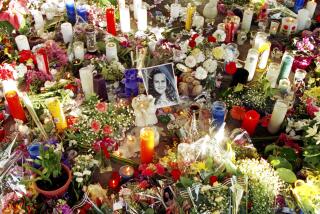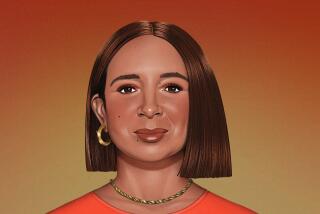They Didn’t Catch Rudolph, but They Stopped Him Cold
OPELIKA, Ala. — Jeffrey Tickal was drinking coffee at McDonald’s when he saw the bomber striding past, and so it was on a McDonald’s coffee cup that he wrote down the man’s license plate number: KND1117.
Tickal had never done anything like that before, and he hasn’t since. Stepping out of McDonald’s and following the man that morning was an instinctive reaction, he said -- “what everyone is supposed to do.”
Despite the extraordinary police effort that went into investigating the deadly bombings in 1996, 1997 and 1998, it was two bystanders -- Tickal and college student Jermaine Hughes -- who provided the single filament of information that led to Eric Rudolph.
On Wednesday, moments after Rudolph pleaded guilty to the bombings, U.S. Atty. Alice Martin finally revealed the names of the men who had been known as WN-1 and WN-2. They have seen but never met each other. Tickal, 41, is now a lawyer in Opelika, and Hughes, 29, has left the South to study law at Harvard.
Martin said Thursday that she would like to see the two men receive a $1-million reward that was offered for identifying the bomber.
“These bombings would never have been solved without these witnesses,” said retired police Lt. Donald Toole, who was commander of the police radio control room the morning of the bombing. “That’s how important they were. Without these witnesses, Rudolph would never have gone into hiding. He knew he had been seen.”
On Thursday, in the graceful, columned house that holds his law practice, Tickal was trying to figure out what to do about his constantly ringing phone. He complained about not getting work done, declined to be photographed and politely asked a television reporter not to go live outside his window. Asked about the reward, Tickal shrugged with what appeared to be a real lack of concern.
“A hero?” said Tickal. “I followed the guy’s tag number. I don’t know what to call it.”
Through his lawyer, Hughes declined to comment for this report, saying the publicity could put him at risk.
In a news conference Wednesday, prosecutors gave a dramatic narration of what happened the morning of Jan. 28, 1998, when Tickal and Hughes followed Rudolph from the site of his fourth bombing.
This strike came in Birmingham, Ala., outside the New Woman All Women Health Care clinic.
After three highly publicized bombings in Atlanta -- at the Olympics, at another women’s clinic and at a nightclub -- police still had only the vaguest sense of who was behind them.
Cryptic letters in which the writer took credit for the bombings had been examined by a psychological profiler. A blurry photograph of a man sitting on a bench in Centennial Olympic Park had been magnified so many times that investigators called it “Blobman,” writes investigator Charles Stone in the book “Hunting Eric Rudolph.”
When the Birmingham bomb went off, at 7:33 a.m., Hughes was in a dormitory laundry room at the University of Alabama campus, about a block away from the clinic, prosecutors said. He looked out the window and saw a crowd of people rushing toward the scene. Then he saw a lone man walking calmly away.
Hughes stepped outside and climbed into his car, driving ahead of Rudolph, who was on foot, and pulling over so he could get a look at the man’s face. Then he ducked into McDonald’s to place a 911 call.
Tickal was inside the restaurant eating his breakfast, about to head to work. He heard Hughes on the phone with police, crying out, “That’s him!” -- and realized Hughes had spotted a man walking past, 40 or 50 yards away. Tickal walked out the door and began following Rudolph, who turned off the sidewalk onto a path that disappeared in the woods.
Tickal said he got in his car and drove in that direction for about half a mile, then turned onto a side street that ended in a parking area. Through luck or strategy -- he still doesn’t know which -- Tickal had turned onto the road where Rudolph had stashed his truck. From his car, Tickal watched Rudolph emerge from the woods and lay some gear in the back of the truck.
When Rudolph pulled out onto Valley Avenue, Tickal made a U-turn and followed him. Rudolph’s Nissan stopped at a light, and Tickal stopped behind him, scribbling the license plate number on his coffee cup. At the next light, Tickal pulled up alongside Rudolph’s truck and tried to get a clear look at his face.
“He was looking at me looking at him,” Tickal said.
That was the narrow slice of time when Tickal saw Eric Rudolph. Tickal turned at the light -- heading for a nearby police officer -- and Rudolph glided forward. By this time, Hughes had spotted Rudolph’s truck too, and called police with the same license plate information.
“What the other witness did was fantastic,” Tickal said. Of himself, he said, “I’m glad I was there.”
With those phone calls, Eric Rudolph became a suspect and went into hiding for five years. Rudolph, in the 11-page statement released Wednesday, mentions the witnesses several times.
“Washington was lucky that day in Birmingham, they had a witness who happened into a fortuitous position, and my truck was identified,” he said. “I knew something was amiss based on the early reports out of Birmingham, so I prepared to make a move as I debated within myself whether or not to run or fight them in court. I chose the woods.”
There were no more bombings after that, although Rudolph had a stockpile of 250 pounds of dynamite.
Jeff Lyons has spent the last seven years helping his wife, Emily, recover from injuries she suffered in the Birmingham blast. Lyons said he looked forward to someday meeting the two witnesses to thank them.
“If you look for a hero in this case, it’s them. The police and the FBI and all the other agents -- they’re paid to be heroes. These guys did it because it was the right thing to do,” Lyons said. “That’s rare in this world.”
More to Read
Sign up for Essential California
The most important California stories and recommendations in your inbox every morning.
You may occasionally receive promotional content from the Los Angeles Times.











